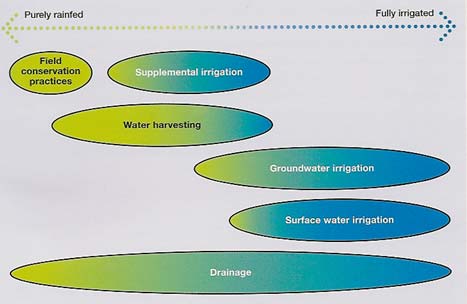| News | Events | Sites | Database | Knowledge Base | Forum |
|
General objective of this concept note Population, population growth and food production Agriculture: what role for development, which linkages with water? Water for agriculture: where do we stand? Which future? WATER FOR AGRICULTURE: WHERE DO WE STAND? WHICH FUTURE? The agricultural land is about 1,500 million ha. About 1,100 ha (73%) is cultivated without a water management system. In about 270 million ha there is an irrigation system only (210 million ha) or an irrigation and drainage system (60 million ha). In about 130 million ha there is a drainage system only. Irrigated agriculture is responsible for 70 to 90% of withdrawals from either surface or groundwater (Annex 1). At global level: annually roughly 7,000 billion m3 of water are required for food production (considering only Et of crops and pastures) that is roughly 1,100 m3/cap/yr of which 1,800 billion m3 comes from irrigation, the other 5,200 billion m3 from rainfall. This is the result of plant functioning: water needs to be evaporated by plants so that they absorb CO2. Producing 1 kg of cereals costs from 500 to 1,500 litres of water. Producing oil or meat costs much more (to the process involved) from 3,000 to 15,000 litres of water per kg produced. Producing 1 kcal requires roughly 1 litre of water. Each person requires a minimum of 2,800 kcal/day i.e. 2,800 litres/day or 1,020 m3/yr. Increasing the productivity of agricultural water is nevertheless possible and required. Three main ways are to be considered:
It looks like the main source of water efficiency increases lies in the improvements in small-scale agriculture (low yields). Better agricultural water management to improve the yields of that agriculture is the key, keeping in mind that water is not the only production factor, others being land, fertilisers, reduction of post harvest losses, looking after virtual water conservation and storage, etc. In the future, the needs are huge to feed the world population due to an expected increase by 50 - 100% by 2050. This increase is especially expected in the emerging and least developed countries. Considering the need to feed the 850 millions under-nourished, the likely diet changes and the population increase, the food production would roughly have to be doubled within 50 years. Which means a range of water for food between 10,000 and 14,000 billion m3. This depends to a large extent of the capacity of small-scale agriculture to increase its productivity (yields and water productivity) and the required expansion of irrigated agriculture. Out of the increase of 3,000 to 7,000 km3, in the rainfed areas without a water management system, water harvesting and watershed management may result in some improvements, especially in the livelihood of poor farm families. There is, however, no way that the cultivated area without a water management system can contribute significantly to the required increase in food production (with the additional threat posed due to Global Climate Change). Due to this the share of irrigated and drained areas in food production will have to increase. This can be either achieved by installing irrigation, or drainage systems in the areas without a system, improvement, or modernisation of existing irrigation and drainage systems, installation of irrigation systems in the rainfed drained areas, or installation of drainage systems in irrigated areas. There is thus a need to consider a series of water management solutions from purely rainfed to large-scale irrigated areas (Figure 2).
Figure 2. Diverse options for agricultural water management along the spectrum At each level of this continuum, the two issues of water storage and efficiency need to be considered depending on the local conditions. Thus a range of proposed solutions needs to be developed, keeping in mind in particular the level of development, the capacities of the farmers, market prices and farm costs, including those of water management. In addition, the evolution of three external factors would have to be examined:
Conclusions Globally water is not limiting for agriculture. But heterogeneity prevails and some countries will increasingly face scarcity. The future needs of water for food are huge and up to date water management systems will be required at a large scale. Increasing the lower yields through better water management practices seems to have the largest potential for water saving and thus for terrestrial ecosystems preservation. |
